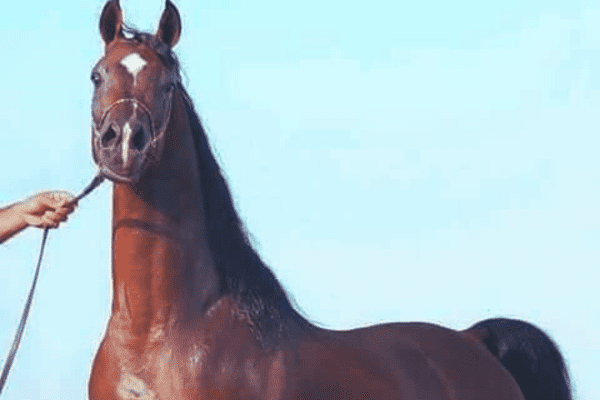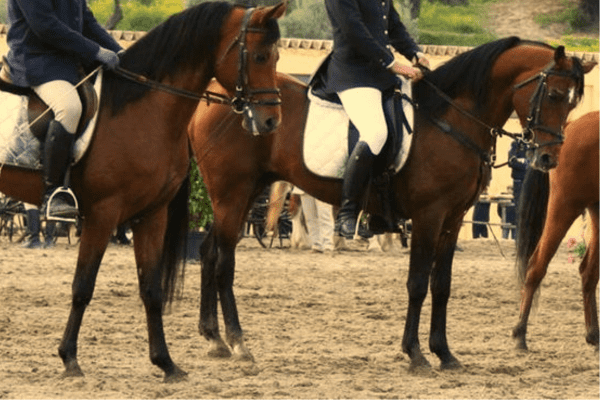The Purosangue Orientale, a distinguished Italian horse breed, represents a unique fusion of history and equine grace. Its origins date back to 1864, when desert-bred Arabian horses were introduced to Sicily, marking a significant chapter in Italian equestrian history.
This importation of Arabians, known for their unparalleled endurance and majestic beauty, was instrumental in shaping the breed’s distinct characteristics. The Purosangue Orientale is a testament to the successful integration of Arabian horses’ traits with the rich equestrian culture of Italy, resulting in a breed that is as versatile as it is captivating.
Renowned for its striking beauty, elegance, and athletic prowess, the Purosangue Orientale stands out in the equine world. It boasts a refined conformation that blends the Arabians’ sleek lines and expressive features with robust Italian breeding.
This combination yields a horse that is not only aesthetically pleasing but also highly capable in various equestrian disciplines. The Purosangue Orientale excels in endurance, speed, and agility, making it a favorite among horse enthusiasts for competitive and recreational purposes alike. This breed is a living symbol of the harmonious blend of Eastern and Western equine heritage, celebrated for its physical and temperamental qualities.
History:
This Purosangue Orientale horse is renowned for its a rich and distinct history that combines the mystical of Arabian horses with Italian horsemanship traditions. This breed’s journey from dry deserts in Saudi Arabia to the Italian peninsula is proof of the long-lasting appeal and value of these magnificent horses.
The development in the Purosangue Orientale is characterized by important historical landmarks and breeding methods, highlighting the unique traits of this breed and the issues it faces today.
Historical Beginnings
Origins of the horse is in Saudi Arabian Deserts: The origins of Purosangue Orientale go back into the desert landscapes that are Saudi Arabia, where its predecessors were Arabian horses, bred for deserts Arabian horse, became famous for their beauty and endurance.
Italian introduction in 1864 In 1864, the Italian government, aware of the importance of these horses and their value, launched an initiative in 1864 to import top-quality Arabian horses drawn from Bedouin tribes of Mesopotamia and Syria with success, bringing many mares and stallions to Sicily.
Formal Recognition and Breeding
Royal Decree No. 1875 The breed was acknowledged within the Kingdom of Italy with the Royal Decree No. 2690, dated September 19th 1875. The decree created a special breeding guide for Purosangue Orientale, highlighting the importance of keeping the pure lineage of the breed.
Rigorous Record-keeping: The stud book required the precise registration of horses that had proven pure heritage and provides breeders with a reliable guideline to select purebred stallions as well as mares.
Physical Characteristics
Mesodolichomorphic Body Mesodolichomorphic Build Purosangue Orientale is identified as mesodolichomorphic or mesomorphic body that has a well-proportioned body and a combination of grace and strength.
Present Challenges
The numbers are declining: Despite its acclaim, the breed has seen a steady decline in its numbers and has prompted government-run breeding programmes to bring in different Arabian breeds to sustain the breed’s health.
Quality Beware: These breeding efforts have raised questions about the diminution of the unique Purosangue Orientale traits, given that they originally possess traits unique from the breeders of desert Arabian lineage.
Recent Developments
The 2008 Studbook Regulations: On June 12th, 2008, new rules for the studbook were approved, allowing crossbreeding with recognized by the WAHO as Arabian horses. But, this has sparked debates over the conservation of the breed’s initial traits.
Comparative Breeding and Utilization
Ability and Versatility: The Purosangue Orientale, which is larger and stronger than WAHO’s standard Arabian horse, it is specifically suitable for military and cavalry usage, as well as for equestrian sport.
Cultural Significance
The evolution of Purosangue Orientale isn’t only about physical characteristics but also the integration of culture. Eastern horsemanship traditions are rooted in a philosophic view of horses as much more than instruments or animals but instead as companions and partners.
This philosophy could have a profound impact on the way these horses are treated and handled, leading to an ethical and respectful approach to breeding horses and the equestrian sport.

Physical Characteristics of the Purosangue Orientale
Build: Typically, it is mesodolichomorphic, or mesomorphic, body type, distinguished by a well-balanced and proportioned body.
Stature: A little larger and more sturdy compared to the standard Arabian horses, displaying an encapsulation of elegance and strength.
Head: Features a delicately stylized, expressive head that is which is reminiscent of its Arabian family.
Eyes: Big eyes with expressive features, which add to their intelligent and alert appearance.
Coat: Has an elegant and shiny coat that comes in a variety of hues, typically showing the sheen characteristic of Arabian horses.
Temperament of the Purosangue Orientale
Intelligence: Very intelligent and quick to master which makes them ideal for many disciplines in equestrian.
Disposition: Well-known for its energetic, but manageable temperament that balances calm and energy.
Trainability: Very capable of being trained, and able to respond well to consistent and gentle handling.
Endurance: Shows extraordinary endurance, which is inherited from their ancestors who were desert breeders.
Ability to adapt to different situations and needs, it is ideal for competitive as well as recreational equestrian sports.

